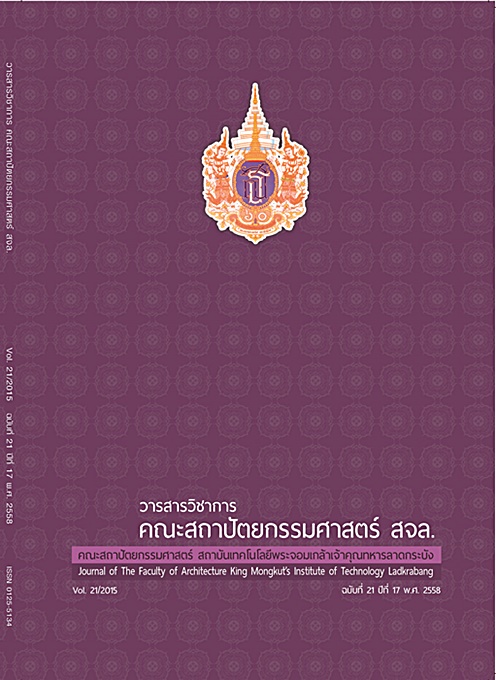แนวทางการใช้สวนหลังคาเพื่อลดการถ่ายเทความร้อนผ่านทางหลังคาดาดฟ้าอาคาร (The Use of Roof Garden to Reduce Heat Transfer Through Flat Slab Roof)
Main Article Content
Abstract
บทคัดย่อ
การที่หลังคาดาดฟ้าอาคารได้รับอิทธิพลจากการแผ่รังสีความร้อนจากดวงอาทิตย์โดยตรง ทำให้มีการสะสมและ
ถ่ายเทความร้อนเข้าสู่ภายในอาคาร มีผลให้อุณหภูมิอากาศภายในอาคารสูงขึ้นซึ่งกระทบต่อสภาวะน่าสบายทางอุณหภูมิของผู้ใช้อาคารและภาระในการปรับอากาศ การวิจัยนี้มีวัตถุประสงค์เพื่อศึกษาแนวทางการใช้สวนหลังคาเพื่อลดการถ่ายเทความร้อนผ่านทางหลังคาดาดฟ้าอาคาร โดยศึกษาอิทธิพลของตัวแปรต่างๆ ที่มีผลทำให้อุณหภูมิผิวด้านล่างหลังคาดาดฟ้าอาคารต่ำที่สุดโดยกำหนดรูปแบบการทดลองทั้งสิ้น 5 รูปแบบ ดังนี้ การทดลองที่ 1 การศึกษาอิทธิพลของดินปลูกในการป้องกันความร้อนของสวนหลังคาการทดลองที่ 2 การศึกษาอิทธิพลของความชื้นภายในดินปลูกที่มีผลต่อการป้องกันความร้อนของสวนหลังคาการทดลองที่ 3 การศึกษาอิทธิพลของวัสดุคลุมดินที่มีผลการป้องกันความร้อนของสวนหลังคาการทดลองที่ 4 การศึกษาอิทธิพลของสภาพแวดล้อมเหนือสวนหลังคา และการทดลองที่ 5 การศึกษาอิทธิพลของการแผ่รังสีความร้อนของดวงอาทิตย์
จากผลการวิจัยสรุปได้ว่า การใช้สวนหลังคาสามารถลดการถ่ายเทความร้อนและลดอุณหภูมิผิวด้านล่างหลังคาดาดฟ้าอาคารลงได้อย่างมีประสิทธิภาพ ซึ่งเป็นผลมาจากอิทธิพลจากดิน อิทธิพลของความชื้นภายในดินและอิทธิพลของการแลกเปลี่ยนความร้อนระหว่างหลังคาดาดฟ้าอาคารกับดินซึ่งในการใช้สวนหลังคาเพื่อลดการถ่ายเทความร้อนผ่านทางหลังคาดาดฟ้าอาคารนั้นควรใช้วัสดุปกคลุมผิวดิน อาทิ หญ้า พืชคลุมดิน เพื่อรักษาความชุ่มชื้นภายในดินและช่วยลดอุณหภูมิที่ผิวดิน อีกทั้งควรใช้ประโยชน์จากพุ่มใบของไม้พุ่มและไม้ยืนต้นเพื่อปรับสภาพแวดล้อมเหนือผิวดินและช่วยป้องกันรังสีความร้อนจากดวงอาทิตย์ซึ่งการใช้ประโยชน์จากดิน วัสดุคลุมดิน ความชื้นภายในดินและการปรับสภาพแวดล้อมโดยการบังเงาให้แก่สวนหลังคาจะช่วยลดการถ่ายเทความร้อนได้อย่างมีประสิทธิภาพ
คำสำคัญ : สวนหลังคา หลังคาดาดฟ้าอาคาร การถ่ายเทความร้อน
Abstract
The temperature of the rooftop surface drastically increased due to the direct effect of solar radiation.This high temperature is then transferred to the bottom surface of the rooftop and result in unfavorable high temperature inside the building. For this reason, this research aims to investigate the five main factors affecting the reduction of heat transfer by the use of the roof garden. It intends to find the ways to minimize the bottom surface temperature of the rooftop. According to this, the influence of soil covering was studied significantly.
The bottom surface temperature of uncovered roof and soil covering roof was monitored primarily. The soil moisture of roof covering was then studied. In testing the effect of soil moisture, dry and wet soils was examined comparatively. Similarly, wet soil without any cover, wet soil cover with grass and wet soil cover with crops were used as roof covering for testing the influence of soil surface. For monitoring the environmental conditions over the roof garden, wet soil cover with grass only, with grass and shrubs, and with grass and trees were investigated. In addition, wet soil cover with in-shade grass and wet soil cover with outdoor grass were studied for the impact of solar radiation.
Resulting in a decrease of the rooftop bottom surface temperature, heat sinks and heat exchange between the rooftop and soil can reduce the effect of heat transfer. In practice, ground covering is very significant; it transfers coolness into soil and maintains soil moisture. Besides, grass, crops, shrubs and trees can improve the environment over the roof garden by screening and blocking solar radiation. Thus, it can be concluded that roof garden can be considered as an insulation for flat slab roof and reduce heat transfer considerably.
Keywords : Roof Garden Flat Slab Roof Heat Transfer
Article Details
This work is licensed under a Creative Commons Attribution-NonCommercial-ShareAlike 4.0 International License.
Copyright Transfer Statement
The copyright of this article is transferred to Journal of The Faculty of Architecture King Mongkut's Institute of Technology Ladkrabang with effect if and when the article is accepted for publication. The copyright transfer covers the exclusive right to reproduce and distribute the article, including reprints, translations, photographic reproductions, electronic form (offline, online) or any other reproductions of similar nature.
The author warrants that this contribution is original and that he/she has full power to make this grant. The author signs for and accepts responsibility for releasing this material on behalf of any and all co-authors.


